 W
WTheodore Roosevelt Jr., often referred to as Teddy or his initials T. R., was an American politician, statesman, conservationist, naturalist, historian, and writer who served as the 26th president of the United States from 1901 to 1909. He previously served as the 25th vice president under William McKinley from March to September 1901, and as the 33rd governor of New York from 1899 to 1900. Having assumed the presidency after McKinley's assassination, Roosevelt emerged as a leader of the Republican Party and became a driving force for anti-trust and Progressive policies.
 W
WAn election for Mayor of New York City was held on November 2, 1886.
 W
WThe 1898 New York state election was held on November 8, 1898, to elect the governor, the lieutenant governor, the Secretary of State, the state comptroller, the attorney general, the state treasurer and the state engineer, as well as all members of the New York State Assembly and the New York State Senate.
 W
WThe 1900 United States presidential election was the 29th quadrennial presidential election, held on Tuesday, November 6, 1900. In a re-match of the 1896 race, incumbent Republican President William McKinley defeated his Democratic challenger, William Jennings Bryan. McKinley's victory made him the first president to win a consecutive re-election since Ulysses S. Grant had accomplished the same feat in 1872.
 W
WThe 1904 United States presidential election was the 30th quadrennial presidential election, held on Tuesday, November 8, 1904. Incumbent Republican President Theodore Roosevelt defeated the Democratic nominee, Alton B. Parker. Roosevelt's victory made him the first president who ascended to the presidency upon the death of his predecessor to win a full term in his own right.
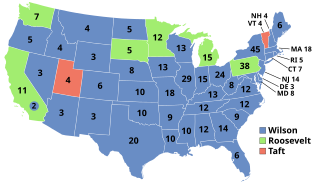 W
WThe 1912 United States presidential election was the 32nd quadrennial presidential election, held on Tuesday, November 5, 1912. Democratic Governor Woodrow Wilson unseated incumbent Republican President William Howard Taft and defeated former President Theodore Roosevelt, who ran under the banner of the new Progressive or "Bull Moose" Party. As of 2021, this is the most recent presidential election in which the second-place candidate was neither a Democrat nor a Republican.
 W
WAlice blue is a pale tint of azure that was favored by Alice Roosevelt Longworth, daughter of Theodore Roosevelt, which sparked a fashion sensation in the United States.
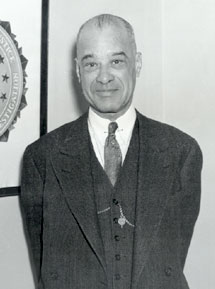 W
WJames Edward Amos was a bodyguard and attendant to U.S. President Theodore Roosevelt Jr. and later became the longest serving African American Federal Bureau of Investigation agent in the pre-modern FBI. He paved the way for future African American FBI agents in a time when not many worked for the federal government.
 W
WThe William Barnes vs. Theodore Roosevelt libel trial was a 1915 case between former president Theodore Roosevelt and New York State Republican Party Chairman William Barnes Jr. Barnes sued Roosevelt for libel following accusations of corruption made by Roosevelt against Barnes. The trial became a high profile news event, and was reported about in newspapers across the country. It ended with Roosevelt's acquittal and played a prominent part in ending Barnes' career as a Republican political leader.
 W
WThe Battle of Las Guasimas of June 24, 1898 was a Spanish rearguard action by Major General Antero Rubín against advancing columns led by Major General "Fighting Joe" Wheeler and the first land engagement of the Spanish–American War. The battle unfolded from Wheeler's attempt to storm Spanish positions at Las Guasimas de Sevilla, in the jungles surrounding Santiago de Cuba, with the 1st U.S. Volunteer Cavalry and the 10th Regular Cavalry.
 W
WThe Battle of San Juan Hill, also known as the Battle for the San Juan Heights, was a major battle of the Spanish–American War fought between an American force under the command of William Rufus Shafter and Joseph Wheeler against a Spanish force led by Arsenio Linares y Pombo. The battle proved to be one of the most significant battles of the war and, along with the Siege of Santiago, a decisive battle in deciding the fate of the United States Army campaign in Cuba. The American forces, outnumbering the Spanish defenders 16-to-one, charged upon the heights and dispersed the Spanish after suffering heavy casualties.
 W
WTheodore Roosevelt Birthplace National Historic Site is a recreated brownstone at 28 East 20th Street, between Broadway and Park Avenue South, in the Flatiron District of Manhattan, New York City. It is a replica of the birthplace and childhood home of 26th president of the United States, Theodore Roosevelt.
 W
WSeth Bullock was a Canadian-American frontiersman, business proprietor, politician, sheriff, and U.S. Marshal. He was a prominent citizen in Deadwood, South Dakota, where he lived from 1876 until his death, operating a hardware store and later a large hotel, the Bullock Hotel.
 W
WThe Bully Pulpit: Theodore Roosevelt, William Howard Taft, and the Golden Age of Journalism is a 909-page historical nonfiction book written by Doris Kearns Goodwin that was published by Simon & Schuster in November 2013. The book covers the progressive period that transformed the United States at the turn of the century, and centers on Theodore Roosevelt and William Howard Taft as key players along with their wives, Edith Roosevelt and Nellie Taft. In parallel, it chronicles the activities of a group of writers working for McClure's Magazine, such as Ida Tarbell and Lincoln Steffens, who helped influence public opinion with their investigative journalism focusing on the increasing power of "trusts" and their associated abuses of power. The book also describes a perception of America that is different from our modern day perception.
 W
WOlivia America Davidson Washington was an American teacher and educator.
 W
WElectoral history of Theodore Roosevelt, who served as the 26th president of the United States (1901–1909), the 25th vice president (1901), and the 33rd governor of New York (1899–1900).
 W
WAnthony Fiala was an American explorer, born in Jersey City, New Jersey, and educated at Cooper Union and the National Academy of Design, New York City. In early life he was engaged in various employments—as lithographic designer, chemist, cartoonist, head of the art and engraving department of the Brooklyn Daily Eagle (1894–99), and correspondent for that paper while serving as a trooper in the Spanish–American War.
 W
WMarcus Alonzo Hanna was an American businessman and Republican politician who served as a United States Senator from Ohio as well as chairman of the Republican National Committee. A friend and political ally of President William McKinley, Hanna used his wealth and business skills to successfully manage McKinley's presidential campaigns in 1896 and 1900.
 W
WAlbert Bushnell Hart was an American historian, writer, and editor based at Harvard University. One of the first generation of professionally trained historians in the United States, a prolific author and editor of historical works, Albert Bushnell Hart became, as Samuel Eliot Morison described him, "The Grand Old Man" of American history, looking the part with his "patriarchal full beard and flowing moustaches."
 W
WThe highland darter is a species of freshwater ray-finned fish, a darter from the subfamily Etheostomatinae, part of the family Percidae, which also contains the perches, ruffes and pikeperches. It is found in the Arkansas and upper White river drainages on the Ozark Plateau of Missouri, Arkansas, extreme southeastern Kansas, and northeastern Oklahoma.
 W
WAlice Hathaway Roosevelt was an American socialite and the first wife of President Theodore Roosevelt. Two days after giving birth to their only child, she died from undiagnosed Bright's disease.
 W
WThe Maltese Cross Cabin is a cabin used by Theodore Roosevelt, before he was President. The cabin is currently located at the visitor center at Theodore Roosevelt National Park, just outside the town of Medora, North Dakota.
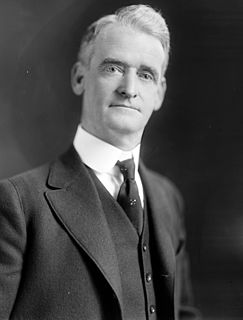 W
WWhitmell Pugh Martin was a U.S. Representative from Louisiana. Although he later served most of his congressional career as a Democrat, Martin was first elected as a "Bull Moose" Progressive in 1914. He is the only individual ever to represent Louisiana in Congress as a member of that party.
 W
WJohn William McGrath was a Canadian amateur ice hockey player and private secretary and advisor to former President of the United States Theodore Roosevelt between 1912–1916.
 W
WMetropolitan is an American magazine, published monthly from 1895 to 1925 in New York City. Former U.S. President Theodore Roosevelt was editor of the magazine during World War I when it focused on politics and literature. It was sometimes named, or called, Metropolitan Magazine or The Metropolitan, and its final issues were published as Macfadden's Fiction-Lover's Magazine.
 W
WAntoine-Amédée-Marie-Vincent Manca Amat de Vallombrosa, Marquis de Morès et de Montemaggiore, commonly known as the Marquis de Morès, was a French duelist, frontier ranchman in the Badlands of Dakota Territory during the final years of the American Old West era, a railroad pioneer in Vietnam, and a politician in his native France.
 W
WThe New York City Police Commissioner is the head of the governing body of the New York City Police Department. The commissioner is appointed by the mayor, and serves at the mayor's pleasure. The commissioner is responsible for the day-to-day operations of the department as well as the appointment of deputies including the Chief of Department and subordinate officers. Commissioners are civilian administrators, and they and their subordinate deputies are civilians under an oath of office, not sworn members of the force. This is a separate position from the Chief of Department, who is the senior sworn uniformed member of the force.
 W
WAlton Brooks Parker was an American judge, best known as the Democrat who lost the presidential election of 1904 to Theodore Roosevelt.
 W
WPine Knot is a historic cabin located 14 miles south of Charlottesville, Virginia in Albemarle County, Virginia. The cabin was owned and occupied by former President of the United States Theodore Roosevelt and his wife Edith Kermit Roosevelt, and used by Roosevelt and the first lady while he was president, although no official business took place there. In 1905, Mrs. Roosevelt spent $280 to purchase the fifteen-acre property with its rustic worker's cabin, and she bought an additional seventy-five acres in 1911. The cabin is owned by the Edith and Theodore Roosevelt Pine Knot Foundation and is open for visits by appointment.
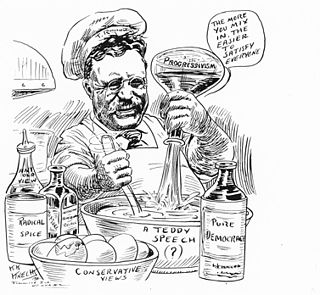 W
WTheodore Roosevelt (1858–1919) was the 26th President of the United States (1901–1909) and also served as Governor of New York and Vice President. He is known for becoming a leading spokesman for his version of progressivism after 1890. However, author Daniel Ruddy argues in his book Theodore the Great: Conservative Crusader that Roosevelt was actually a "populist conservative" and a "Hamiltonian"—a conservative in the eighteenth century sense of the word. Similarly, Francis Fukuyama identifies Roosevelt, together with Alexander Hamilton, as part of a tradition of a strong-state conservatism in the United States.
 W
WThe presidency of Theodore Roosevelt started on September 14, 1901, when Theodore Roosevelt became the 26th president of the United States upon the assassination of President William McKinley, and ended on March 4, 1909. Roosevelt had been the vice president for only 194 days when he succeeded to the presidency. A Republican, he ran for and won by a landslide a four-year term as president in 1904. He was succeeded by his protégé and chosen successor, William Howard Taft.
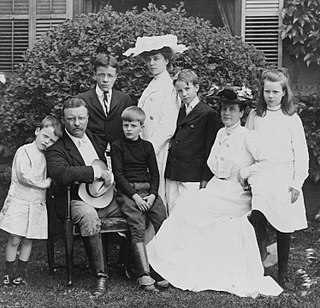 W
WThe Roosevelt family is an American political family from New York whose members have included two United States presidents, a First Lady, and various merchants, bankers, politicians, inventors, clergymen, artists, and socialites. The progeny of a mid-17th-century Dutch immigrant to New Amsterdam, many members of the family became locally prominent in New York City politics and business and intermarried with prominent colonial families. Two distantly related branches of the family from Oyster Bay and Hyde Park, New York, rose to national political prominence with the presidencies of Theodore Roosevelt (1901–1909) and his fifth cousin Franklin D. Roosevelt (1933–1945), whose wife, First Lady Eleanor Roosevelt, was Theodore's niece.
 W
WRoosevelt Republican is a term used in discussions about politics of the United States to describe people with beliefs reminiscent of American President Theodore Roosevelt, a politician who spent much of his career as a Republican. Roosevelt's political positions were diverse but his name has been generally deployed by politicians who wish to publicly align themselves with Roosevelt's record of conservation.
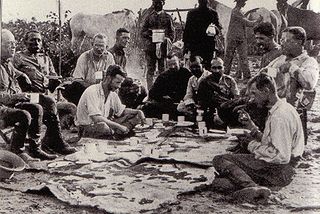 W
WThe Roosevelt–Rondon Scientific Expedition was a survey expedition in 1913–14 to follow the path of the Rio da Dúvida in the Amazon basin. The expedition was jointly led by Theodore Roosevelt, the former President of the United States, and Colonel Cândido Rondon, the Brazilian explorer who had discovered its headwaters in 1909. Sponsored in part by the American Museum of Natural History, they also collected many new animal and insect specimens. The river was eventually named "Rio Roosevelt" for the former president, who nearly died during the voyage.
 W
WTheodore Roosevelt High School, originally Roosevelt High School, the third public high school to open in the Bronx, New York, operated from 1918 until its permanent closure in 2006. Shutting down incrementally since 2002, this large high school, initially enrolling about 4 000 students, yearly dwindled, newly sharing its 1928 building with new, small public high schools—all pooling students for major, extracurricular activities like athletics and JROTC—a reorganization renaming the building Theodore Roosevelt Educational Campus, still open after the historic, namesake high school ceased in 2006. At its November 1918 opening, Roosevelt High School operated in the building of school PS 31.
 W
WTheodore Roosevelt Inaugural National Historic Site preserves the Ansley Wilcox House, at 641 Delaware Avenue in Buffalo, New York. Here, after the assassination of William McKinley, Theodore Roosevelt took the oath of office as President of the United States on September 14, 1901. A New York historical marker outside the house indicates that it was the site of Theodore Roosevelt's Inauguration.
 W
WRoosevelt's World War I volunteers was a proposed military volunteer formation of Americans to fight in France for the Allies.
 W
WThe Rough Riders was a nickname given to the 1st United States Volunteer Cavalry, one of three such regiments raised in 1898 for the Spanish–American War and the only one to see combat. The United States Army was small, understaffed, and disorganized in comparison to its status during the American Civil War roughly thirty years prior. Following the sinking of USS Maine, President William McKinley needed to muster a strong ground force swiftly, which he did by calling for 125,000 volunteers to assist in the war. The U.S. had gone to war in opposition to Spanish colonial policies in Cuba, which was then torn by a rebellion. The regiment was also nicknamed "Wood's Weary Walkers" for its first commander, Colonel Leonard Wood. This reflected their dissatisfaction that despite being cavalry, they ended up fighting in Cuba as infantry, since their horses were not sent there with them.
 W
WSagamore Hill was the home of the 26th president of the United States, Theodore Roosevelt, from 1885 until his death in 1919. It is located in Cove Neck, New York, near Oyster Bay on the North Shore of Long Island, 25 miles (40 km) east of Manhattan. It is now the Sagamore Hill National Historic Site, which includes the Theodore Roosevelt Museum in a later building on the grounds.
 W
WThe Smithsonian–Roosevelt African Expedition was an expedition to Africa led by American president Theodore Roosevelt and outfitted by the Smithsonian Institution. Its purpose was to collect specimens for the Smithsonian's new Natural History museum, now known as the National Museum of Natural History. The expedition collected around 11,400 animal specimens which took Smithsonian naturalists eight years to catalog. Following the expedition, Roosevelt chronicled it in his book African Game Trails.
 W
WIn American folklore, the snallygaster is a bird-reptile chimera originating in the superstitions of early German immigrants later combined with sensationalistic newspaper reports of the monster. Early sightings associate the snallygaster with Frederick County, Maryland, especially the areas of South Mountain and the Middletown Valley. Later reports would expand on sightings encompassing an area to include Central Maryland and the Washington, DC, metro area.
 W
WTahawus was a village in the Town of Newcomb, Essex County, New York, United States. It is now a ghost town situated in the Adirondack Park. Tahawus is located in Essex County within the unpopulated northern area designated to the town of Newcomb. Tahawus was the site of major mining and iron smelting operations in the 19th century. Although standing as recently as 2005, the last mining facilities have since been demolished and removed.
 W
WUSS Theodore Roosevelt (CVN-71) is the fourth Nimitz-class, nuclear-powered, aircraft carrier in the United States Navy. She is named in honor of Theodore Roosevelt, the 26th President of the United States and a proponent of naval power. She is the fourth ship named in honor of Theodore Roosevelt, three bearing his full name and a fourth with just his last name. Another three U.S. Navy ships have "Roosevelt" in their names in honor of members of the Roosevelt family. This carrier's radio call sign is "Rough Rider", the nickname of President Roosevelt's volunteer cavalry unit during the Spanish–American War. She was launched in 1984, and saw her first action during Operation Desert Storm in 1991.
 W
WSince his death in 1919, his family and admirers have from time to time, attempted to establish a Theodore Roosevelt Presidential Library and Museum. All have failed. The first attempt became a national historic site in New York City and the papers themselves were donated to Harvard University. There was another attempt in the 1990s near where Roosevelt had his home in Sagamore Hill, NY. The latest attempt is in North Dakota, where Roosevelt lived for a few years in the 1880s.
 W
WThe Theodore Roosevelt United States Courthouse is a courthouse in Downtown Brooklyn, New York City, that houses the United States District Court for the Eastern District of New York. It is across the street from the Federal Building and Post Office, which houses, among other things, the Eastern District of New York's bankruptcy court.
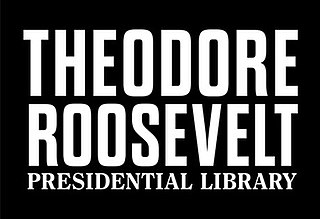 W
WThe Theodore Roosevelt Presidential Library will be a museum and facility for the records of Theodore Roosevelt, the 26th president of the United States. It is to be constructed at a site to the west of Medora, North Dakota, near Theodore Roosevelt National Park, which preserves sites associated with Roosevelt's sojourn in North Dakota between 1883 and 1887. The project is in planning stages. A site in the Badlands of Medora was selected in 2020, as well as the design architect Snøhetta and the architect of record JLG Architects.
 W
WOn October 16, 1901, shortly after moving into the White House, President Theodore Roosevelt invited his adviser, the African American spokesman Booker T. Washington, to dine with him and his family; it provoked an outpouring of condemnation from southern politicians and press. This reaction affected subsequent White House practice and no other African American was invited to dinner for almost thirty years.
 W
WJoe Wiegand is an impersonator who has portrayed U.S. President Theodore Roosevelt in all fifty U.S. states, after a career as a political consultant. Wiegand performed at the White House on October 27, 2008 as part of the celebration of the 150th anniversary of Roosevelt's birth. He also modeled for a new Theodore Roosevelt sculpture commissioned the American Museum of Natural History. Wiegand is also a member and contributor to Theodore Roosevelt Association.
 W
WOwen Wister was an American writer and historian, considered the "father" of western fiction. He is best remembered for writing The Virginian and a biography of Ulysses S. Grant.